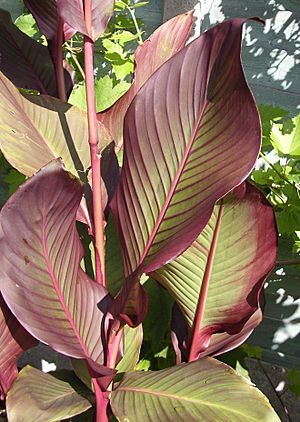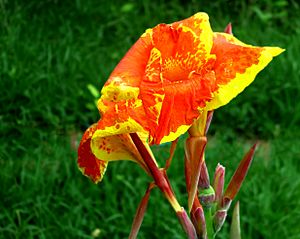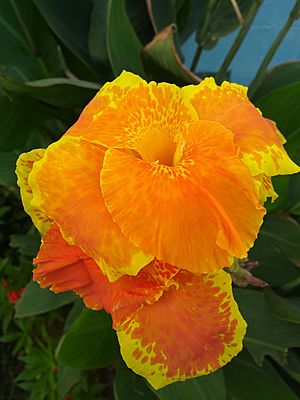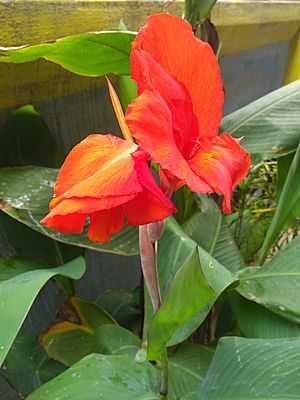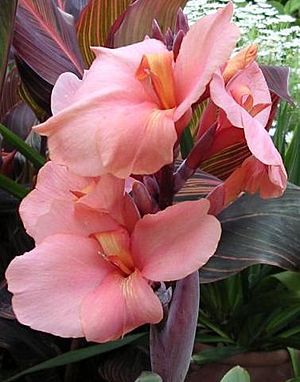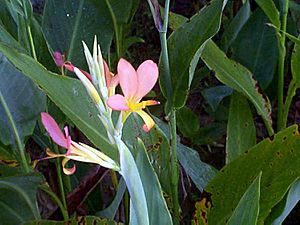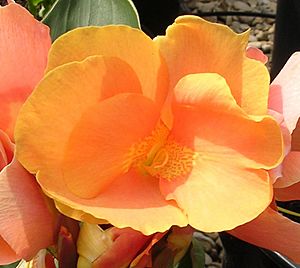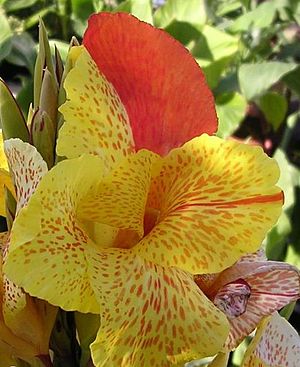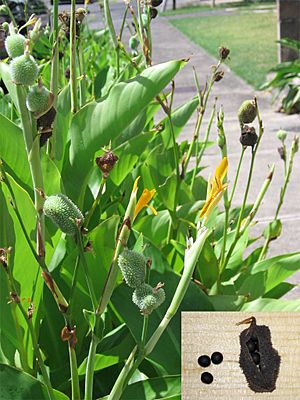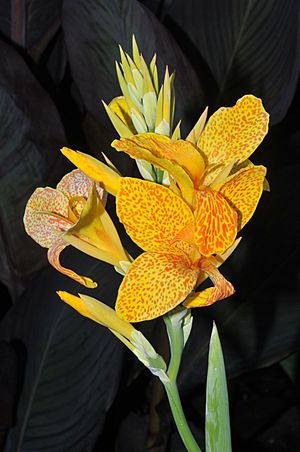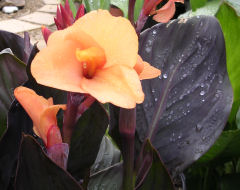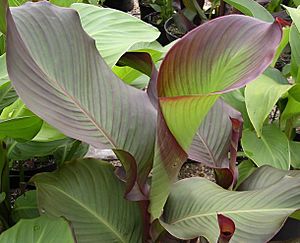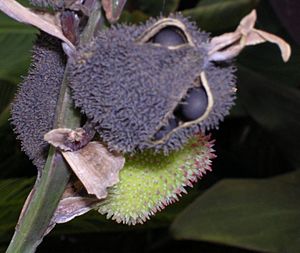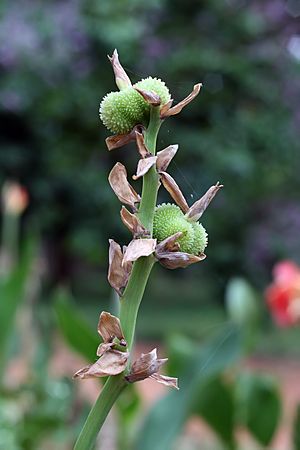Canna (plant) facts for kids
Quick facts for kids Canna (plant) |
|
|---|---|
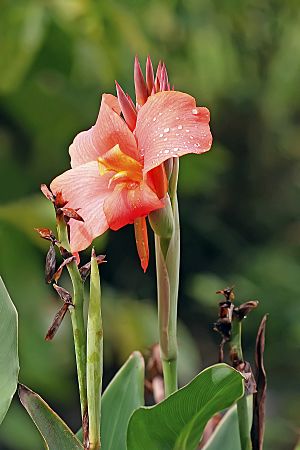 |
|
| Canna hybrid flowers and foliage | |
| Scientific classification |
|
| Kingdom: | Plantae |
| Clade: | Tracheophytes |
| Clade: | Angiosperms |
| Clade: | Monocots |
| Clade: | Commelinids |
| Order: | Zingiberales |
| Family: | Cannaceae Juss. |
| Genus: | Canna L. |
| Species | |
|
19 classified species, see List of Canna species |
|
The Canna plant, also known as canna lily, is a beautiful flowering plant. It's the only type of plant in its family, called Cannaceae. There are about 10 different kinds, or species, of Canna plants.
Even though they are sometimes called "canna lilies," they are not true lilies. Instead, they are related to plants like gingers, bananas, and heliconias.
Canna plants have large, eye-catching leaves and bright flowers. Gardeners love to grow them because they add a tropical feel to gardens. Farmers also grow cannas because their underground stems, called rhizomes, are full of starch. This starch can be used for both people and animals to eat.
Even though cannas come from warm, tropical places, many types can grow in cooler areas. They need at least 6 to 8 hours of sunlight each day in summer. In winter, they need to be kept warm.
The name Canna comes from a Latin word meaning "cane" or "reed."
Contents
What are Canna Plants Like?
Canna plants are large, herbaceous plants that grow back year after year. They have thick, underground stems called rhizomes. Their wide, flat leaves grow in a roll and then unfurl. Most leaves are green, but some types have brownish, maroon, or even mixed-color leaves.
Canna flowers look a bit unusual. They have three small outer leaves called sepals and three small inner leaves called petals. What looks like the main petals are actually modified stamens, which are the parts that usually hold pollen. These modified stamens are very showy. One special modified stamen is called the labellum. The flower also has a part called the pistil, which connects to a three-part ovary where seeds develop.
The flowers are usually red, orange, or yellow, or a mix of these colors. They grow in clusters called inflorescences. These bright flowers attract pollinators like bees, hummingbirds, sunbirds, and even bats, which help the plant make seeds.
Wild Canna plants can grow quite tall, sometimes up to 2 to 3 meters (6.5 to 10 feet). However, many garden types are smaller.
The rhizomes of Canna plants store a lot of starch. In fact, Canna plants have the largest starch grains of any plant! This makes them very useful in farming.
Canna is the only plant in its group (called monocots) where seeds can "sleep" for a long time. This is because their seeds have a very hard outer shell.
Canna History
The Canna indica species, also known as achira, has been grown by Native Americans in tropical America for thousands of years. It was one of the first plants grown for food in the Americas. Its starchy root can be eaten.
The first Canna plant brought to Europe was C. indica. It came from the East Indies, but it originally came from the Americas. Early descriptions of the plant noted that it was called "indica" not because it was from India in Asia, but because it was first brought from America. At that time, the tropical parts of America were sometimes called the West Indies.
All Canna species brought to Europe came from the Americas. This means that Canna plants are originally from the Americas. If they had grown in Asia or Africa for a long time, archaeologists would have found old Canna seeds there.
Canna Family Tree
| Cladogram: Phylogeny of Zingiberales | |||||||||||||||||||||||||||||||||||||||||||||||||||
|
Scientists study how plants are related to each other. The diagram above, called a cladogram, shows how Canna plants fit into a larger group called Zingiberales. This group includes their close relatives like gingers, bananas, and heliconias.
Types of Canna Species
Even though there are many types of Canna plants grown in gardens today (called cultivars), there are about 20 known wild species. In recent years, scientists have reduced the number of accepted Canna species. Many plants once thought to be different species are now considered to be the same, just with different names.
You can find a full list of Canna species and their descriptions at List of Canna species.
Where Do Cannas Grow?
Canna plants naturally grow in warm and mild areas of the New World. This stretches from the southern Southern United States (like South Carolina and Texas) all the way down to northern Argentina.
The C. indica species has spread to many tropical places around the world. It can be hard to remove and is sometimes considered an invasive plant.
Gardeners grow Canna plants in most countries, even those with short summers. Cannas grow quickly, making them a good choice for gardens. They just need 6 to 8 hours of sunlight daily during their growing season and protection from cold winters.
Canna Plant Problems
Pests
Cannas are usually quite strong against pests. However, in the US, they can sometimes be attacked by the canna leaf roller moth. This moth damages the leaves, which can be annoying for gardeners, but it usually doesn't kill the plant.
Slugs and snails also enjoy eating canna leaves, especially the young, unfurling ones. If cannas are grown indoors or during very hot summers, tiny Red spider mites can become a problem. Japanese beetles can also cause damage if not controlled.
Diseases
Compared to many other plants, cannas don't get sick very often. But they can get a fungal disease called canna rust, which causes orange spots on the leaves. This often happens if the soil is too wet.
Cannas can also get certain plant viruses. Some of these viruses are specific to Canna plants. In a mild form, they might cause spotted or streaked leaves. But in more serious cases, they can make the plant stop growing and cause twisted flowers and leaves.
Sometimes, a fuzzy gray mold called botrytis can grow on older flowers, especially when it's humid. To fix this, simply remove the old flowers so the mold doesn't spread.
How to Grow Cannas
Cannas grow best in full sun with a moderate amount of water. They like rich or sandy soil that drains well. They grow from underground rhizomes. In colder places, people often grow them as annuals (plants that live for one season) to give their gardens a tropical look. In dry areas, cannas are sometimes grown in water gardens, with the bottom of their pot submerged. Strong winds can tear their leaves, so it's good to plant them in a sheltered spot.
Canna rhizomes are sensitive to frost. If left in freezing conditions without protection, they will rot. In areas where winter temperatures drop below -10°C (14°F), the rhizomes should be dug up before it freezes. Then, they can be stored in a warm place (above 7°C or 45°F) and replanted in the spring. Otherwise, a thick layer of mulch can protect them over winter.
What are Cannas Used For?
- Many types of cannas are grown in gardens around the world. They can be planted in flower beds, tropical garden designs, or in pots on patios.
- Globally, cannas are very popular garden plants, and a big industry relies on them.
- The rhizomes of cannas are full of starch and are used in agriculture. All parts of the plant can be useful:
- The hard seeds are used as beads in jewelry.
- The seeds are also used inside musical instruments like the kayamb (from Réunion) and the hosho (a gourd rattle from Zimbabwe).
- A fiber from the stem can be used as a substitute for jute.
- Fibers from the leaves can be used to make paper.
- A purple dye can be made from the seeds.
- Smoke from burning canna leaves is thought to repel insects.
- Cannas can help clean up polluted water in wetlands because they can handle many different pollutants.
- In Thailand, cannas are a traditional gift for Father's Day.
- In Vietnam, canna starch is used to make cellophane noodles called miến dong.
- Cannas attract hummingbirds, which helps create good habitats for pollinators and wildlife.
Garden Varieties (Cultivars)
Cannas became very popular garden plants during Victorian times. They were widely grown in many countries. Some types from that time, like Canna × ehemannii, are still available today. This plant is tall with green leaves and pink, iris-like flowers.
After two world wars, cannas became less popular because many gardeners went off to war. However, recently, interest in Canna plants has grown again. There used to be hundreds of different types, but many are now gone. In 1910, a book described over 500 different Canna types.
In recent years, many new types have been created. However, many popular cannas have several different names, which can be confusing. Over 2,800 Canna names have been recorded, but many are just different names for the same plant.
Award-Winning Cannas
Some Canna types have won the Royal Horticultural Society's Award of Garden Merit. This award means they are excellent plants for gardens. Here are some of them:
- 'Alaska' (cream with yellow)
- 'Annaeei' (large blue-green leaves)
- C. × ehemannii (deep pink)
- 'Erebus' (coral pink)
- 'General Eisenhower' (bronze leaves, orange flowers)
- 'Louis Cayeux' (salmon pink)
- 'Musifolia' (large leaves with bronze color)
- 'Mystique' (bronze leaves)
- 'Phasion' (bronze leaves, orange flowers)
- 'Picasso' (yellow with red spots)
- 'Russian Red' (bronze leaves)
- 'Shenandoah' (flesh pink)
- 'Verdi' (bright orange)
- 'Whithelm Pride' (bright pink)
- 'Wyoming' (bright orange)
Farming Varieties
The Canna Agriculture Group includes all the types of Canna grown for farming. "Canna achira" is a general term used in South America for cannas grown for food. These are usually types of C. discolor. They are grown mainly for their edible rootstock (rhizomes), which provide starch. The leaves and young seeds can also be eaten. Achira was once a very important food crop in Peru and Ecuador. Studies have shown that achira can produce a lot of rhizomes and starch per hectare, but it takes 9 to 12 months to grow fully.
Many traditional types of cannas are grown around the world for food. These have been chosen by people over time for their good qualities. Canna edulis is often said to be the species grown for food in South America, but it's likely the same as C. discolor, which is also grown for farming in Asia.
How Cannas Grow New Plants
Growing from Seeds
Canna plants can grow from seeds, which are made when pollen from one part of the flower (the stamen) lands on another part (the stigma). Most Canna plants can pollinate themselves. However, many garden types need help from an outside pollinator. All cannas make nectar, which attracts insects, bats, and hummingbirds. These animals help move pollen between flowers.
Canna seeds have a very hard outer shell, which makes them "sleep" for a while. To help them sprout, you can scratch or nick the seed coat.
When you grow a Canna plant from a seed, the new plant will be a bit different from its parent plant. This is because of genetic recombination. Wild Canna species usually grow true to their type, but even they can have some differences. The C. indica species, for example, has many different forms, from giant to tiny, with various leaf and flower colors.
Growing from Plant Parts
The easiest way to grow new Canna plants without seeds is by dividing their rhizomes. This method creates new plants that are exactly like the parent plant. After a summer of growth, you can separate a large rhizome into smaller pieces. Each piece needs to have a "growing eye" or bud, which is where new shoots will start. Without this growing point, the rhizome won't grow.
Scientists can also grow many new plants very quickly using a method called micropropagation, or tissue culture. This involves growing tiny pieces of the plant in a sterile lab environment. This method can also be used to get rid of viruses in plants.


